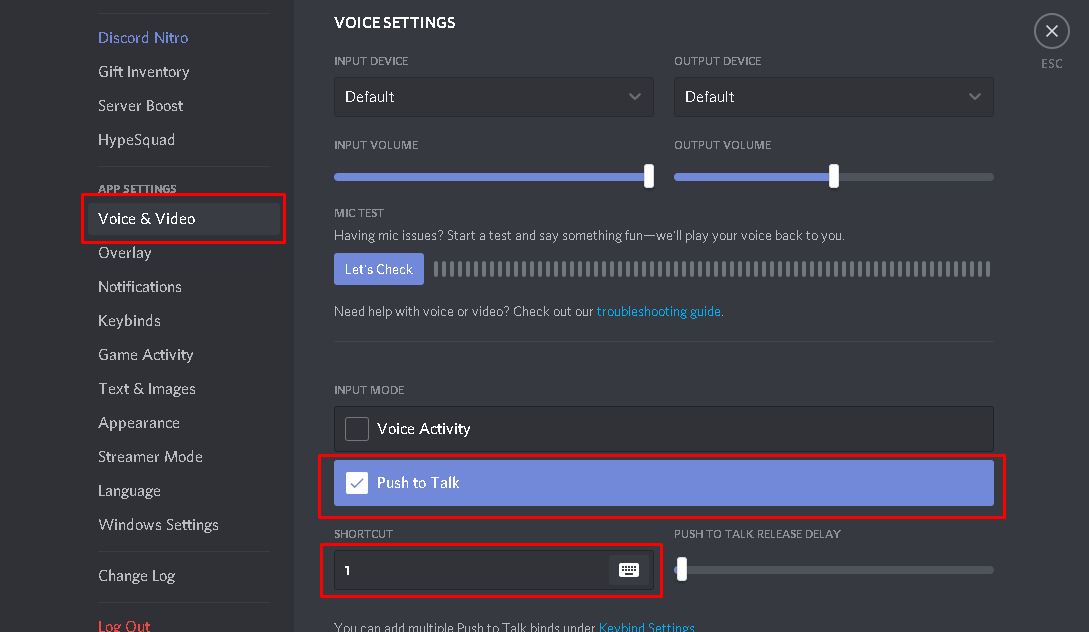

- PUSH TO TALK RELEASE DELAY DISCORD RECOMMENDATION PLUS
- PUSH TO TALK RELEASE DELAY DISCORD RECOMMENDATION DOWNLOAD

Doing this will ensure that no sound is heard when you use the PTT feature. This will turn off the PTT sound when you push to talk.Īdditionally, you can also choose to have your microphone muted when you push to talk by checking the box next to the “Mute my mic when joining a call” option.

To turn it off, open your user settings, select the “Voice & Video” tab, and then uncheck the box next to the “Push to Talk” option. You've now officially passed your first class in Discord's voice input methods! Get out there and proclaim your awesomeness to your friends, with either PTT or Voice Activity.Yes, you can get rid of the Discord Push to Talk (PTT) sound.
PUSH TO TALK RELEASE DELAY DISCORD RECOMMENDATION DOWNLOAD
If you want to use PTT system wide, you'll have to download the desktop client! Important note #2: Push-to-Talk only works in the browser app when the window is in focus. Oh, and remember how we have that pesky 200ms delay from Voice Activity? Guess what? Push-to-Talk has 0. Think of PTT like a door your keybind is what opens the door, and the Release Delay is how long it takes for that door to close. This important tool affects how long PTT waits to cut off audio after you let go of your dedicated keybind. Last point on Push-to-Talk: The PTT Release Delay slider. Once your desired PTT key is in the box, you're ready to begin pushing to talking. To do this, just click on the shortcut box, and press your desired PTT key. Since we've got the input mode selected already, all that's standing between us and sharing our innermost thoughts with our buddies is setting a keybind. Push-to-Talk (PTT) changes things up a bit, in the sense that Discord doesn't pass any incoming audio at all unless you press and hold a dedicated "PTT key".
PUSH TO TALK RELEASE DELAY DISCORD RECOMMENDATION PLUS
Important note about Voice Activity mode: due to how Voice Activity functions, there is an inherent 200ms delay, plus the distance you are from the active server. This will take some tweaking on your part! Remember, we want to put the sensitivity marker right between your softest speaking voice and any other noise coming through. Make sure the bar is only yellow when you're not speaking.īut still low enough so that it doesn't cut out your voice when you speak softly: The key here is to leave the sensitivity marker high enough that nothing is transmitted when you're not speaking: When you do uncheck the box, you'll be given the option to adjust your input sensitivity by yourself. While Discord is usually pretty good at this, some of you guys might have some serious room noise, or wide variances in speaking volume. Why's that? Essentially what's happening is that Discord is trying to adjust your mic to an ideal speaking level based on the volume of what's coming into your mic. If your mic jumps from too loud to too soft, or some of your voice is getting cut off at the end of sentences, uncheck this box! There's only one setting to mess with here, and that's input sensitivity!Ĭhances are, if you're using the desktop client, the "Automatically Determine Input Sensitivity" has impacted your audio in some way, shape, or form. This is most likely the more familiar method for users. Note: If you're having trouble with Push-to-Talk while running a game in Administrator mode, check out this article. To access either of these methods, just maneuver through your User Settings > Voice & Video tab. Here we'll address what's going on with Discord's two voice input modes, Push-to-Talk and Voice Activity.


 0 kommentar(er)
0 kommentar(er)
